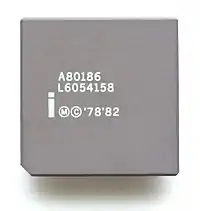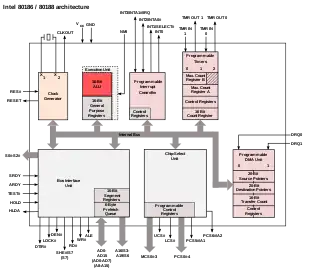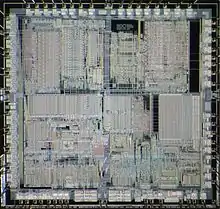Intel 80186
The Intel 80186, also known as the iAPX 186,[5] or just 186, is a microprocessor and microcontroller introduced in 1982. It was based on the Intel 8086 and, like it, had a 16-bit external data bus multiplexed with a 20-bit address bus. The 80188 variant, with an 8-bit external data bus was also available.
 An Intel A80186 processor in a gray ceramic package. | |
| General information | |
|---|---|
| Launched | 1982 |
| Discontinued | September 28, 2007[1] |
| Common manufacturer(s) | |
| Performance | |
| Max. CPU clock rate | 6 MHz to 25 MHz |
| FSB speeds | 6 MHz to 25 MHz |
| Data width | 16 bits |
| Address width | 20 bits |
| Architecture and classification | |
| Application | Desktop, Embedded |
| Technology node | 3 µm[3] to 1 µm[4] |
| Instruction set | x86-16 |
| Physical specifications | |
| Transistors |
|
| Co-processor | 8087 and later, 80187 (for 80186 only) |
| Package(s) | |
| Socket(s) | |
| Products, models, variants | |
| Variant(s) | |
| History | |
| Predecessor(s) | Intel 8088 |
| Successor(s) | Intel 80386 (The 80286 was also introduced in early 1982, and thus contemporary with the 80186) |
| Support status | |
| Unsupported | |


Description
The 80186 series was generally intended for embedded systems, as microcontrollers with external memory. Therefore, to reduce the number of integrated circuits required, it included features such as clock generator, interrupt controller, timers, wait state generator, DMA channels, and external chip select lines.
The initial clock rate of the 80186 was 6 MHz, but due to more hardware available for the microcode to use, especially for address calculation, many individual instructions completed in fewer clock cycles than on an 8086 at the same clock frequency. For instance, the common register+immediate addressing mode was significantly faster than on the 8086,[lower-alpha 1] especially when a memory location was both (one of) the operand(s) and the destination. Multiply and divide also showed great improvement, being several times as fast as on the original 8086 and multi-bit shifts were done almost four times as quickly as in the 8086.
A few new instructions were introduced with the 80186 (referred to as the 8086-2 instruction set in some datasheets): enter/leave (replacing several instructions when handling stack frames), pusha/popa (push/pop all general registers), bound (check array index against bounds), and ins/outs (input/output of string). A useful immediate mode was added for the push, imul, and multi-bit shift instructions. These instructions were also included in the contemporary 80286 and in successor chips.[lower-alpha 2]

The (redesigned) CMOS version, 80C186, introduced DRAM refresh, a power-save mode, and a direct interface to the 80C187 floating point numeric coprocessor. Intel second sourced this microprocessor to Fujitsu Limited around 1985.[6] Both packages for Intel 80186 version were available in 68-pin PLCC and PGA in sampling at third quarter of 1985.[7] The available 12.5 MHz Intel 80186-12 version using the 1.5-micron HMOS-III process for USD $36 in quantities of 100.[8] The available 12.5 MHz Intel 80C186 version using the CHMOS III-E technology using approximately 90 mA under normal load and only 32 mA under power-save mode. It was available in 68-pin PLCC, CPGA, or CLCC package.[9] The military version of Intel M80C186 embedded controller was available in 10 and 12 MHz version. They met MIL-STD-883 Rev. C and MIL-STD-1553 bus application standards. The 12 MHz CHMOS version consumes approximately 100 mA. The available packages were 68-pin CPGA and CQFP. The 10 MHz M80C186 PGA version was available for USD $378 in 100-unit quantities.[10] The available 80C186EB in fully static design for the application-specific standard product using the 1-micron CHMOS IV technology. They were available in 3- and 5-Volts version with 84-lead PLCC and 80-lead EIAJ QFP version. It was also available for USD $16.95 in 1,000 unit quantities.[11]
Uses
In personal computers
Because the integrated hardware of the 80186, designed with embedded systems in mind, was incompatible with the hardware used in the original IBM PC, the 80286 was chosen to succeed the 8086, in the IBM PC/AT and other PC-compatible systems.
Several notable personal computers used the 80186:
- the Danish Regnecentralen: RC750 Partner running CCP/M
- the Danish Regnecentralen: RC759 Piccoline running CCP/M
- the Australian Dulmont Magnum laptop, one of the first laptops
- the Wang Office Assistant, marketed as a PC-like stand-alone word processor
- the MAD-1, a semi–IBM PC-compatible desktop computer with a modular design
- the Pronto System 16, another PC compatible
- the Mindset, a very early graphics workstation
- the Siemens PC-D (not 100% IBM PC compatible but using MS-DOS 2.11)
- the Compis, a Swedish school computer
- the French SMT-Goupil G4
- the RM Nimbus PC-186, the first version of a series of British school computers
- the Unisys ICON, a Canadian school computer
- the ORB Computer by ABS
- the HP 100LX, HP 200LX, HP 1000CX, and HP OmniGo 700LX
- the Tandy 2000 desktop, a somewhat PC-compatible workstation with sharp graphics for its day
- the Telex 1260, a desktop PC-XT compatible
- the Philips :YES
- the Nokia MikroMikko 2
- and the IBM PCradio.
In addition to the above examples of stand-alone implementations of the 80186 for personal computers, there were at least two examples of "add-in" accelerator card implementations: the BBC Master 512, Acorn's plug-in for the BBC Master range of computers containing an 80186-10 with 512 KB of RAM, and the Orchid Technology PC Turbo 186,[12] released in 1985. It was intended for use with the original Intel 8088-based IBM PC (Model 5150).
Other devices
The Intel 80186 is intended to be embedded in electronic devices that are not primarily computers. For example:
- the 80186 was used to control the Microtek 8086 in-circuit emulator[13]
- its offshoot, Intel 80188 was embedded inside the Intel 14.4EX modem released in 1991. The 16 MHz processor was used to perform complex algorithms needed for forward error correction, Trellis modulation, and echo cancellation in the modem
- the IBM 7171 protocol converter, which made ASCII character-oriented terminals appear as an IBM 3270 terminal to an IBM mainframe,[14] used the Intel 80186 as its CPU.[15]
In May 2006, Intel announced that production of the 186 would cease at the end of September 2007.[16] Pin- and instruction-compatible replacements might still be manufactured by various third party sources,[17] and FPGA versions are publicly available.[18]
See also
Notes
- In fact, all variants, including reg+reg and reg+reg+immediate were faster.
- The instruction set of the 80286 is a superset of the 80186's, plus new instructions for protected mode.
References
- "Product Change Notification" (PDF). 2 May 2006. Archived from the original (PDF) on 23 October 2006.
- CPU http://www.cpu-world.com.
- "3 µm lithography process - WikiChip". en.wikichip.org.
- Intel Corporation, "New Product Focus: Components: New ASSP Suits Mobile Applications", Microcomputer Solutions, September/October 1990, page 11
- iAPX 286 Programmer's Reference (PDF). Intel. 1983. page 1-1.
- Intel Corporation, "NewsBits: Second Source News", Solutions, January/February 1985, Page 1
- Ashborn, Jim; "Advanced Packaging: A Little Goes A Long Way", Intel Corporation, Solutions, January/February 1986, Page 2
- Intel Corporation, "New Product Focus Component: 80186-12 Microprocessor: Fast And Formidable", Solutions, March/April 1986, page 10
- Ormsby, John, Editor, "New Product Focus: Components: It's Under Control With The 80C186", Intel Corporation, Microcomputer Solutions, November/December 1987, page 13
- Intel Corporation, "Focus: Components: Fast M80C186 Embedded Controller Cuts Power Usage", Microcomputer Solutions, March/April 1989, page 12
- Intel Corporation, "New Product Focus: Components: New ASSP Suits Mobile Applications", Microcomputer Solutions, September/October 1990, page 11
- Crabb, Don (20 May 1985). "Adding Spunk to the IBM PC". InfoWorld. Vol. 7, no. 20. p. 49.
- EEVblog #410 - Microtek 8086 In-Circuit Emulator Teardown. EEVBlog. 15 January 2013 – via YouTube.
- Brear, Scott (21 January 1985). "Cycle of change speeds up". Computerworld. Vol. 19, no. 3. IDG Enterprise. pp. ID/15. ISSN 0010-4841.
- 7171 Reference Manual and Programming Guide (PDF). IBM Corporation. 1986. pp. 4–13. GA37-0021-0.
- "Intel cashes in ancient chips". Archived from the original on 2011-08-13. Retrieved 2009-01-19.
- "Innovasic Offers Replacement ICs for Intel 186/188 Microcontrollers". Archived from the original on 2012-02-13. Retrieved 2009-01-19.
- "Jamie Iles - Software + Hardware | 80186 CPU". www.jamieiles.com.